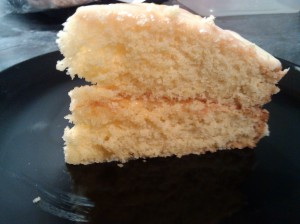 Here’s a cake I made a few weeks ago in honour of my sister-in-law, who told me a while back that she really likes lemony, coconutty cakes: a coconut cake with a lemon cream cheese filling.
Here’s a cake I made a few weeks ago in honour of my sister-in-law, who told me a while back that she really likes lemony, coconutty cakes: a coconut cake with a lemon cream cheese filling.
I’ve made a three-layer version of this before, but I wanted something less faffy (and less likely to topple over), so I combined the filling from that recipe with my usual coconut cake sponge recipe to bring it down to two layers.

The filling is really quite something – I bought the lemon curd, but if you’re happy to make it from scratch, then I suspect it’d be even better! The sharpness of the lemon against the unnnngggh-ness (yes, that’s a word) of the full-fat soft cheese is truly delicious!
I only used the zest of one lemon in the sponges and couldn’t really taste it, so I’ve recommended two lemons in my recipe below.
I assembled this on a really hot day and it started to droop a bit after a few hours, so make sure you eat it up very quickly if you also make it for a special summer occasion… which I’m pretty sure won’t be a problem!
Coconut cake with lemon cream cheese filling recipe
Serves 10
For the sponge layers:
- 175g softened butter
- 175g caster sugar
- 175g self raising flour
- 1.5 tsp baking powder
- 3 eggs, beaten
- 75g dessicated coconut
- 2 tbsp coconut cream (I used Patak’s coconut cream, which comes in sachets)
- finely grated zest of two lemons
For the filling:
- 75g unsalted butter
- 75g icing sugar
- 200g soft cheese
- one-quarter tsp vanilla extract
- 2 tsp lemon juice
- 100g good quality lemon curd
Method:
- Preheat the oven to 180C/gas mark 4. Butter and line the base of two 20 cm/8 inch sandwich tins with greaseproof paper.
- Mix the butter, sugar, flour, baking powder and eggs for 2-3 minutes until smooth. Gently stir in the dessicated coconut, coconut cream and lemon zest.
- Divide the mixture between the two tins and smooth the tops. Bake for 20-25 minutes until evenly golden and firm.
- Loosen the edges and leave the tins to cool for 5 minutes and then transfer on to a wire rack to cool. Peel off the lining paper.
- For the filling, beat together the butter and icing sugar, then beat in the soft cheese, vanilla and lemon juice.
- Sandwich the cakes with the lemon curd and cream cheese filling. Sift a little icing sugar on top and serve.

































